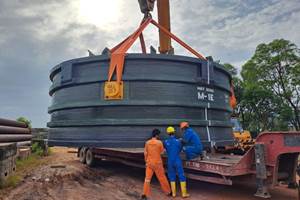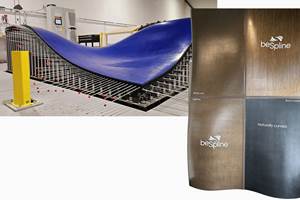Is a composites technical talent shortage looming?
Regular CW columnist Dale Brosius, also the chief commercialization officer for the Institute for Advanced Composites Manufacturing Innovation (IACMI, Knoxville, TN, US), calls for more schools with curricula that mint engineers with undergraduate degrees in composites.
If you are a proponent of composites (and as a reader of this magazine, I assume you are), you have to be encouraged by all the developments underway and the growth potential of the industry. Examples abound: The need for lighter weight automobiles, to meet fuel economy and CO2 emission targets, is stimulating innovation and investment across the globe in advanced composites. Clean energy sources, such as wind turbines, are becoming increasingly competitive with fossil fuels, and are creating enormous demand for resins, fiberglass and carbon fiber. Forecasts in these key applications call for double-digit growth for many years as composites become more ubiquitous.
If the forecasts are accurate, there also will be a huge demand for trained composites technicians, manufacturing engineers and designers able to avoid the “black metal” approach to structural analysis. Where will we find the people to design the components and assemblies, run the manufacturing equipment, and repair the resulting parts when they are damaged? More than the need to add manufacturing capacity, it’s concern about finding talented people that keeps composites industry owners and senior managers awake at night. And the skills required today and in the future aren’t the same as those that sufficed 20 years ago, when buckets, brushes and manual chopper guns dominated fiberglass shops, and hand layup dominated composite aircraft part making. With the advent of resin infusion and RTM for continuous glass fiber (and many carbon fiber) parts, and automated tape layup or fiber placement for prepregs, today’s (and tomorrow’s) technicians and engineers require a higher level understanding to diagnose issues and keep production rates high.
In July, ÂÌñÏ×ÆÞ editor-in-chief Jeff Sloan opined that the composites industry has too many “old” people and not enough “young” people to replace those retiring with many years of composites experience. As one of the “old” people with 30-plus years of experience — but not yet ready to retire — I think we run the risk of not having enough trained workers at all ages.
There is no doubt we need to attract young people. Within professional societies, such as SPE and SAMPE, the average age continues to rise. Although we expend a lot of financial resources on scholarships and support of student activities, these don’t translate to membership growth at the rate we need to see, let alone the industry’s growth rate. One reason for the lack of attraction is that younger generations connect through social media rather than face-to-face, so we must think about our messaging — how do deliver our appeal more effectively using these new tools?
Part of the message is that the composites industry is a high-tech industry, with an increasing reliance on modeling and simulation tools, and automated equipment for fabrication and assembly of composite structures. We also need to emphasize the sustainability aspects of composites: Our products, in fact (and despite the use of some, when cured, absolutely inert petroleum-based materials), reduce global warming and support green-energy solutions — the wind energy industry and fuel-cell technology, for example — concerns increasingly important to younger generations.
Although many of our universities have done an excellent job with graduate-level degree programs focused on research in composites, we still need more schools to create curricula that mint manufacturing and design engineers with undergraduate degrees in composites, especially in the US. I am always impressed when I go to Europe, particularly Germany, where I see a lot of young engineers obtaining credit toward an advanced degree by working full time in a composites manufacturing environment, rather than in a research setting. This kind of real-world experience today creates the manufacturing managers of tomorrow.
The initiatives we need aren’t only for the young; retraining of workers in stagnant industries as composites technicians is also on the radar — not just for the companies that will employ them, but also for state economic development organizations, hoping to attract companies to take advantage of such talent. The American Composites Manufacturing Assn. (Arlington, VA, US) has made a good start with its Certified Composites Technician (CCT) program in the US, and this could be accelerated with help from workforce development efforts in each state and by focused composites institutes, such as the Institute for Advanced Composites Manufacturing Innovation (IACMI, Knoxville, TN, US). Similar efforts of which I am aware are underway in the UK, France and Germany.
Engineers are trained to solve real-world problems, and the potential shortage of talent in the composites industry is just such a problem, seeking a solution. Collectively, industry, government and academia can — indeed, must — effectively address this issue to keep the composites industry on its upward trajectory.
Related Content
GFRP Tech launches South African facility for GFRP rebar production
Said to be the first of its kind in this region, GFRP Tech will manufacture, test and supply flagship EnviraBar and EnviraMesh products to support South Africa’s infrastructure modernization.
Read MoreComposites end markets: Infrastructure and construction (2024)
Composites are increasingly used in applications like building facades, bridges, utility poles, wastewater treatment pipes, repair solutions and more.
Read MorePlant tour: BeSpline/Addcomp, Sherbrooke, QC, Canada
Composites automation specialist increases access to next-gen technologies, including novel AFP systems and unique 3D parts using adaptive molds.
Read MoreBrainDrip scales up composite technology to meet current, future energy infrastructure needs
Next-generation composite pipe development with embedded, AI-enhanced health monitoring will modernize new and aging pipelines globally.
Read MoreRead Next
Next-gen fan blades: Hybrid twin RTM, printed sensors, laser shock disassembly
MORPHO project demonstrates blade with 20% faster RTM cure cycle, uses AI-based monitoring for improved maintenance/life cycle management and proves laser shock disassembly for recycling.
Read MoreScaling up, optimizing the flax fiber composite camper
Greenlander’s Sherpa RV cab, which is largely constructed from flax fiber/bio-epoxy sandwich panels, nears commercial production readiness and next-generation scale-up.
Read MoreCutting 100 pounds, certification time for the X-59 nose cone
Swift Engineering used HyperX software to remove 100 pounds from 38-foot graphite/epoxy cored nose cone for X-59 supersonic aircraft.
Read More











